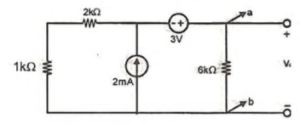PUNJAB PUBLIC SERVICE COMMISSION
COMBINED COMPETITIVE EXAMINATION FOR RECRUITMENT TO THE
POSTS OF PROVINCIAL MANAGEMENT SERVICE, ETC. (BS-17) – 2015
SUBJECT: PRINCIPLE OF ENGINEERING (PAPER-I)
TIME ALLOWED: THREE HOURS MAXIMUM MARKS: 100
Note: Attempt any FIVE questions. All questions carry equal marks. Use of Calculator is allowed.
Q.1. (a) State Boyle’s Law, Charles’ Law and show how these are consistent with the ideal gas equation.
(b) Volume of a gas inside a balloon is increased when heated. Explain why that happens in terms of the Kinetic Theory.
(c) A U-tube manometer using mercury shows that the gas pressure inside a tank is 30cm. Calculate the gauge pressure of the gas inside the vessel. Take g = 9.78m/s2, density of mercury = 13,550 kg/m3.
Q.2. Calculate Molarity for each of the following solution
(a) 30 g of Co(NO3)2.6H20 in 4.3L of solution.
(b) 30 mL of .5M H2SO4 diluted to 500mL.
Q.3. A 1/2 inch diameter steel bar increases in length from 10 cm to 10.4 cm under an applied force of 10,000 lbf.
(a) What is the stress in the bar?
(b) What is the strain in the bar?
(c) What is the change in diameter of the bar?
Q.4. (a) Define thermodynamics. Justify that it is the science to compute energy, energy and entropy.
(b) Show that the First law of thermodynamics throws light on concept of internal energy. The Second law indicates the limit of converting heat into work and introduces the principle of increase of entropy and Third law defines the absolute zero of entropy.
Q.5. A body of mass 5 kg slides a distance of 6 m down a rough Inclined plane 30 degree. Then it moves on frictionless horizontal surface and compresses a spring. The coefficient of kinetic friction is 0.1 and the spring constant is 300 N/m. Find the maximum compression of the spring.
Q.6. Use a 230/12 V transformer in a full wave rectifier draw complete circuit diagram and calculate accurately DC output voltage.
Q.7. Define Thevenin’s Theorem and find Thevenin’s Equivalent of the following circuit across 6 K resistance.
Q.8. Find the reactions at the supports of the beam shown in following fig.

